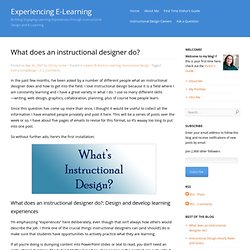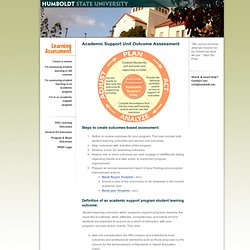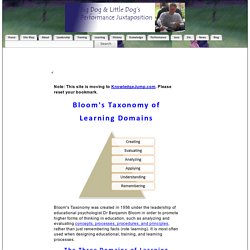

What does an instructional designer do? In the past few months, I’ve been asked by a number of different people what an instructional designer does and how to get into the field.

I love instructional design because it is a field where I am constantly learning and I have a great variety in what I do. I use so many different skills—writing, web design, graphics, collaboration, planning, plus of course how people learn. Since this question has come up more than once, I thought it would be useful to collect all the information I have emailed people privately and post it here.
This will be a series of posts over the week or so. I have about five pages of emails to revise for this format, so it’s waaay too long to put into one post. So without further ado, here’s the first installation: What does an instructional designer do? I’m emphasizing “experiences” here deliberately, even though that isn’t always how others would describe the job. How do we do that?
Update: Other Posts in this Series Free Subscription. Designing Your Courses for Significant Learning Outcomes. Outcomes, Learning Activities, Assessment. Steps to create outcomes-based assessment: Define or review outcomes for your program.

This may include both student learning outcomes and service unit outcomes. Align outcomes with activities of the program. Develop a plan for assessing outcomes. Assess one or more outcomes per year, engage in staff/faculty dialog regarding results and take action to implement program improvement. Definition of an academic support program student learning outcome: Student learning outcomes within academic support programs describe the expected knowledge, skills, attitudes, competencies, and habits of mind students are expected to acquire as a result of interaction with your program, services and/or events. Definition of a service unit outcome (SUO): Academic support programs often are involved in informing students (and others) as to bureaucratic processes, regulations, policies, and procedures of the university. Outcomes-based assessment results: Additional hints for success: StudentLearningOutcomes.jpg (584×550)
Creating significant learning experiences: an integrated approach to ... - L. Dee Fink. The Big Mistake in Elearning. Learning_outcomes_chart.png (511×321) Bloom's Taxonomy of Learning Domains. Note: This site is moving to KnowledgeJump.com.

Please reset your bookmark. Bloom's Taxonomy was created in 1956 under the leadership of educational psychologist Dr Benjamin Bloom in order to promote higher forms of thinking in education, such as analyzing and evaluating concepts, processes, procedures, and principles, rather than just remembering facts (rote learning). It is most often used when designing educational, training, and learning processes. The Three Domains of Learning The committee identified three domains of educational activities or learning (Bloom, et al. 1956): Cognitive: mental skills (knowledge) Affective: growth in feelings or emotional areas (attitude or self) Psychomotor: manual or physical skills (skills) Since the work was produced by higher education, the words tend to be a little bigger than we normally use. While the committee produced an elaborate compilation for the cognitive and affective domains, they omitted the psychomotor domain.
Cognitive Domain Review. Applying Bloom's Taxonomy. Blooms_old.png (587×502) Bloom's Taxonomy Verbs. Bloom pyramid.jpg (1371×876)